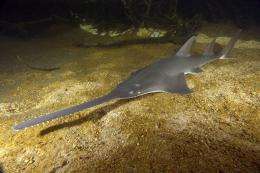What sawfish really do with their saw

Scientists thought that sawfish used their saw to probe the sea bottom for food. But a Cairns researcher has found that these large (5 meters or more) and endangered fish actually use the saw to locate and dismember free-swimming fish – using a sixth sense that detects electric fields. She’s in Melbourne this week as a winner of Fresh Science.
Some of the subjects she studied in Cairns are now Melbourne residents – at the Melbourne Aquarium, the only aquarium in the world with freshwater sharks and sawfish.
The sawfish saw—an elongation of their head with teeth along its sides—provides this sixth sense, she says. It is packed with thousands of tiny pore-like organs which can detect the minute electric fields surrounding living organisms. And it can also be used to attack its prey.
“Northern Australia is considered to be the last stronghold in the world for four species of sawfish,” says Barbara who works at the universities of Queensland and Western Australia and with Cairns Marine (an aquarium fish collecting company). “But if we do not understand these animals, we will not be able to save them.”
Her work is being presented for the first time in public through Fresh Science, a communication boot camp for early career scientists held at the Melbourne Museum. Barbara was one of 16 winners from across Australia.
Sawfish are beautiful and mystic ancient predators, Barbara says. They are regularly taken as by-catch in fisheries, and their fins and saws are traded as highly priced medicines, curios and culinary delicacies. The saws are packed with sensors known as ampullary pores which can detect electric fields, the distribution of which is influenced by how the sawfish captures its prey.
Barbara compared the distribution of ampullary pores in four species of sawfish, which all inhabit remote ecosystems in northern Australia. She found that sawfish have much more concentrated collections of pores on the upper side of the saw than their relatives the shovel-nosed rays. This indicates that they use their saw to detect prey in the three-dimensional space above the saw.
The number of ampullary pores in the different species of sawfish is related to the visibility of their habitat. So the species that inhabit the murkiest waters with the least visibility possess the highest concentration of pores.
Behavioural experiments showed that freshwater sawfish also attack fish with lateral swipes of their saw that can be so powerful as to split the fish in half, Barbara says. She will be reporting in more detail on this new work later this year.
“Barbara’s work is changing our understanding of how sawfish live and hunt, and will contribute to the global efforts to conserve these majestic creatures,” says her supervisor Prof Shaun Collin from The University of Western Australia.”
Provided by Fresh Science

















